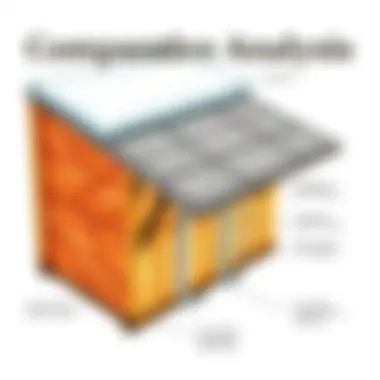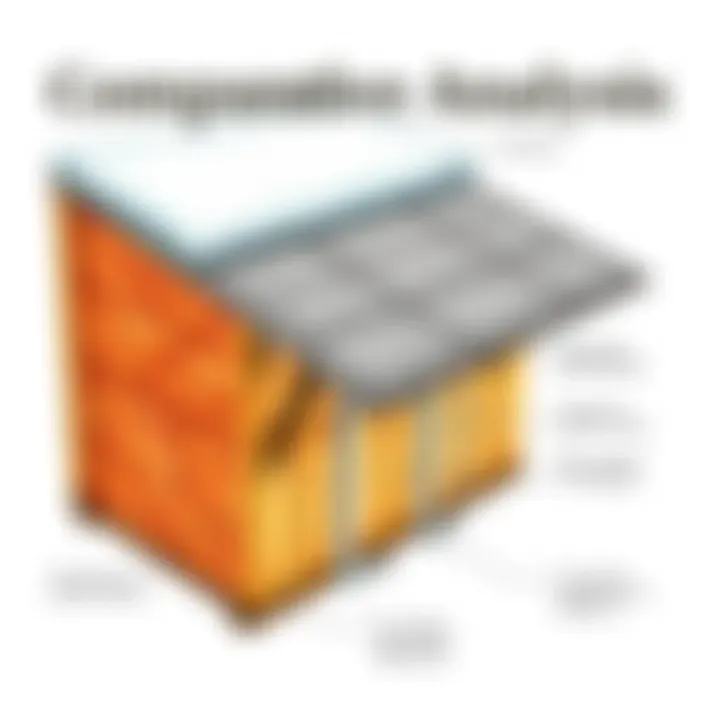Comprehensive Guide to Home Insulating Materials


Intro
When it comes to keeping your home cozy or as cool as a cucumber, insulation plays a pivotal role. Understanding the various types of insulating materials is like having the key to maintaining the perfect temperature inside your home. While some folks may think insulation is just for winter, it’s equally important during the summer months. With so many products available, it can be a bit overwhelming, but fear not! This guide aims to break down the details of insulating materials, covering everything from their properties to best practices. This way, both homeowners and those seeking to learn can make smart decisions about their insulation choices.
Science Fun Facts
Let’s kick things off with some intriguing tidbits related to insulation that you might not know about!
- Insulation Material Evolution: Did you know that the very first insulating materials were made from natural resources such as wool and straw? Today, we have advanced materials like fiberglass and spray foam that offer much more efficiency.
- R-value Value: The effectiveness of insulation is measured in R-value. The higher the R-value, the better the insulation. For instance, closed-cell spray foam insulation can achieve an R-value of 6 to 7 per inch, while fiberglass batts usually hover around 2.9 to 3.7.
- Sound and Insulation: Not only does insulation control temperature but it also helps to minimize sound. For many homeowners, soundproofing is as crucial as temperature control, especially in shared living spaces.
"Choosing the right insulation can significantly reduce your energy bills and improve overall comfort at home."
- Eco-Friendly Options: Some modern insulation materials are made from recycled products. For instance, cellulose insulation is derived from recycled paper, making it a greener option.
In the world of home insulation, these facts paint a picture of constantly evolving materials and innovations that help us create better living environments.
Understanding Insulating Materials
Now, let’s explore the various types of materials used for insulation around the house. Here are the most common options available:
- Fiberglass Insulation: Often found in batt form, fiberglass has been popular for decades. It's fire resistant and provides decent thermal and sound insulation.
- Spray Foam Insulation: This expanding foam is ideal for sealing gaps and cracks, offering a robust R-value. Its effectiveness minimizes air leakage, making it a favorite for many.
- Cellulose Insulation: An eco-friendly alternative, cellulose is made from recycled materials. It’s typically blown into walls and attics and works efficiently against drafts.
- Mineral Wool: Also known as rock wool, this material is made from volcanic rock or recycled steel. It provides excellent fire resistance and soundproofing capabilities.
In the next sections, we’ll further dissect how these materials impact various areas of a home, from attics to basements.
Prelude to Insulation
Insulation isn't just about keeping the cold air out in winter or the warm air in during summer. It's fundamental to the overall comfort of any home. Proper insulation not only stabilizes temperature, but it also contributes to energy efficiency, which translates to lower utility bills. In a world where every penny counts, understanding the nuts and bolts of insulating materials becomes paramount. This section is your roadmap to navigating the realm of insulation, highlighting exactly what it is, why it matters, and how it can enhance your living environment.
Understanding Insulation
At its core, insulation is a material or combination of materials that slows down the transfer of heat. Think of it as a cozy blanket for your home. Just as a blanket traps your body heat, insulation keeps the heat in during the winter and blocks it during the summer. This not only makes for a comfortable living space, but it also sustains your home’s energy efficiency.
Several factors come into play when discussing insulation. The kind of material, its R-value (a measure of thermal resistance), and its placement all affect how effective it can be. While many people assume that insulation is solely for attics or walls, it’s vital to consider every space – from floors to crawlspaces, and even around windows and doors.
Importance of Proper Insulation
A well-insulated home can make all the difference regarding comfort and expenses. Here’s why doing it right matters:
- Energy Efficiency: Good insulation means your heating and cooling systems don’t have to work overtime. This can lead to significant savings on energy bills.
- Indoor Comfort: Extreme temperatures can create uncomfortable living conditions. Proper insulation helps maintain a consistent temperature throughout the house.
- Environmental Impact: Reducing energy consumption not only saves money but also lessens your carbon footprint. It’s a two-for-one deal; you save while being kinder to our planet.
- Prevention of Moisture Problems: Quality insulation can help manage moisture levels, which is crucial in preventing mold and mildew, particularly in areas like attics and basements.
- Increased Home Value: Homes with superior insulation tend to have a higher resale value. Prospective buyers often look for energy-efficient features.
"Investing in insulation today can yield dividends for years in comfort and savings!"
In summary, insulation plays a critical role in creating a more efficient, comfortable, and valuable home. Understanding and utilizing the correct insulating materials is essential for any homeowner looking to optimize their living space.
Types of Insulating Materials
When it comes to ensuring comfort within a home, choosing the right insulating materials plays a crucial role. This section sheds light on various types of insulation available, their unique characteristics, advantages, and considerations for installation. With a deep dive into this topic, homeowners can navigate through the bewildering options, determining which fits their specific needs best while keeping energy efficiency in mind.
Fiberglass Insulation
Composition and Properties
Fiberglass insulation is made from tiny glass fibers woven together to form a mat. This structure allows it to trap air, providing excellent thermal resistance. It’s popular for its non-combustibility and high resistance to moisture. Notably, the inherent flexibility of fiberglass enables it to conform to irregular spaces, making it useful in various areas throughout the home.
However, care is needed during installation, as fiberglass particles can be irritating to the skin and lungs. Wearing protective gear is recommended.
Advantages
One of the standout benefits of fiberglass insulation is its cost-effectiveness. Compared to other materials, it typically comes with a lower price tag, making it accessible for many homeowners. Additionally, it boasts high R-values, meaning it offers great thermal resistance alongside durability.
Not to forget, it is widely available and can be easily installed by either professionals or savvy DIYers. Nonetheless, its effectiveness can diminish if it becomes compressed or damp, impacting its performance.
Installation Considerations
When considering fiberglass, proper installation is key to maximizing its benefits. It is generally installed in batts or rolls, fitting snugly into wall studs. One important aspect to keep in mind is to avoid gaps or voids during installation, which can lead to thermal bridging, reducing overall insulating performance.
If you decide on fiberglass, ensuring proper air sealing around electrical boxes and pipes is crucial. Also, checking local building codes will help you align with regulations for insulation levels and barriers.
Foam Board Insulation
Types of Foam Board
There are primarily two types of foam board insulation: extruded polystyrene (XPS) and expanded polystyrene (EPS). XPS is known for its water resistance and is often used in areas exposed to moisture, like foundations. On the other hand, EPS is lighter and slightly less costly, yielding good thermal performance but with less moisture resistance.
The choice between the two often hinges on application requirements and moisture exposure. Both types offer remarkable insulating properties and can dramatically reduce heat loss in homes.
Applications
Foam board insulation is versatile and can be used in walls, roofs, and even under concrete slabs. Its solid structure provides insulation suitable for both new constructions and retrofits, significantly improving energy efficiency in older buildings. In particular, properties with slab foundations benefit substantially from foam board insulation as it prevents thermal bridging through the concrete.
It's important, though, to ensure that the foam boards are adequately sealed to prevent air leaks that can compromise thermal performance.
Performance Metrics


When evaluating foam board insulation, the R-value is pivotal. It measures thermal resistance; the higher the R-value, the better the material's insulating effectiveness. Typically, foam boards provide R-values ranging from 3.5 to 6.5 per inch of thickness, making them efficient choices for insulating basements and exterior walls.
However, the costs can be slightly higher than traditional batts, which makes it important to weigh the long-term energy savings against upfront expenses.
Spray Foam Insulation
Characteristics
Spray foam insulation consists of a mixture of chemicals sprayed onto surfaces, where it expands and hardens into a solid foam. This expansion characteristic allows it to fill even the slightest gaps, creating a tight seal. It's particularly effective in hard-to-reach areas like attic nooks and crawl spaces. Its air-sealing qualities help to mitigate drafts, leading to reduced energy consumption.
However, it often requires professional installation due to the complexity of methods and materials used, which can increase initial costs.
Benefits over Traditional Insulation
One primary advantage of spray foam is its superior air-sealing ability, which significantly reduces energy loss compared to traditional insulations. It also acts as a vapor barrier, minimizing moisture infiltration. Homes insulated with spray foam report lower energy bills and enhanced comfort. Additionally, its longevity—often lasting for decades without needing replacement—is an appealing factor for many homeowners.
That said, some homeowners find the upfront costs—or the necessity for a professional installer—daunting, but the energy savings gained can outweigh these concerns over time.
Potential Drawbacks
On the flip side, spray foam insulation can have issues if not installed correctly. Improper application may lead to air pockets that actually reduce effectiveness and require expensive remediation. Furthermore, unvented spray foam can present issues with moisture management, especially in specific climates.
These risks make it vital to engage with reputable professionals who understand local building codes and can provide quality workmanship.
Cellulose Insulation
Material Source
Cellulose insulation is primarily made from recycled paper products, such as newspapers and cardboard, making it an environmentally friendly option. This sustainability aspect appeals to many homeowners looking to reduce their environmental footprint. Its production process involves treating these products with fire retardants, allowing it to function safely in homes.
That said, the treatment chemicals—though compliant with safety regulations—can be a point of concern for some homeowners. On the plus side, cellulose insulation often uses less energy to produce compared to synthetic alternatives.
Installation Methods
Cellulose can be blown into attics or walls as loose fill, providing good coverage and fitting snugly into spaces. It can also be packed into wall cavities as dense-pack cellulose, which can be an effective method for homes with existing walls. Each installation method has its intricacies, so professional support can ensure a proper application and consistent performance.
However, homeowners should be aware of potential settling issues over time with loose-fill installations, which may necessitate additional reapplication for maximum efficacy.
Environmental Impact
Using cellulose insulation brings a reduced demand for new materials, thus lowering the overall carbon footprint associated with traditional insulation materials. Its reliance on recycled content can appeal to eco-conscious homeowners. However, cellulose can be vulnerable to moisture if not well-sealed, leading to the potential for mold growth, which makes attentive installation crucial.
Mineral Wool Insulation
Fire Resistance Properties
Mineral wool, composed of natural or synthetic fibers, is notable for its exceptional fire resistance. It can withstand high temperatures without melting, making it suitable for areas where fire safety is a priority, like around chimneys and appliances. This safety feature provides homeowners with peace of mind, especially in homes located in regions prone to wildfires.
Despite its benefits, it doesn't have the same acoustic dampening properties as some other options, which may limit its use in sound-sensitive areas.
Acoustic Benefits
On the sound absorption front, mineral wool has fairly good acoustic properties, absorbing sound well. This benefit can contribute to a quieter indoor environment, a significant consideration in densely populated areas or multi-family homes.
However, it's essential to combine it with other sound-dampening structures for the best acoustic outcomes.
Cost and Installation
In terms of cost, mineral wool insulation typically lands on the higher end of the scale but can be justified by its performance and longevity. Installation can be somewhat straightforward, relying on batt or loose-fill methods. Yet, the higher weight can be cumbersome and might necessitate professional installation.
Homeowners must evaluate whether the long-term savings on energy bills and fire safety compensation for the higher initial investment.
Insulation for Different Parts of the Home
When it comes to insulation in a household, understanding how to tailor insulation applications to various areas is essential. Each part of a home presents unique challenges and opportunities for effective energy management. Proper insulation not only enhances energy efficiency but also improves comfort and can significantly reduce heating and cooling costs. In this section, we’ll dive into the distinctive insulating needs for attics, walls, floors, as well as windows and doors.
Attic Insulation
Optimal Materials
Choosing the right insulation materials for the attic is crucial because this space tends to have the most significant heat loss or gain depending on the season. Fiberglass and spray foam are often recommended due to their excellent insulative properties. Fiberglass batts, for example, are favored for their affordability and ease of installation. On the other hand, spray foam offers air sealing benefits alongside insulation, which is a big plus. However, spray foam also comes with a higher cost. The trade-off between initial expenses and long-term savings makes the choice important.
Installation Best Practices
When installing insulation in the attic, careful planning is key. It isn’t just about laying material down willy-nilly. One must ensure the attic is clean, dry, and properly ventilated during this process. Ensuring that insulation is tucked neatly into the joists can help avoid gaps where heat might escape. Proper use of protective gear is also necessary; safety comes first. This approach provides the best balance of efficiency and safety.
Importance of Ventilation
Proper ventilation in the attic cannot be understated. It's essential for preventing moisture buildup that can lead to mold growth and structural damage. Without adequate ventilation, even the best insulation can fail to perform effectively. So, having vents that allow airflow while keeping pests out is key. It is a balancing act, ensuring that warm air escapes while cool air enters. Maintaining this airflow helps maintain the integrity of your insulation and prolongs its lifespan.
Wall Insulation
Types of Insulation for Walls


The walls of a home are pivotal in regulating internal temperatures. Various insulations, including fiberglass, cellulose, and foam board, each bring unique properties to the table. Fiberglass batts are great for typical stud walls, while cellulose might be a better option for retrofitting old homes. The decision largely depends on budget and environmental considerations. Cellulose, for instance, is made from recycled materials, making it an eco-friendly choice.
Methods of Installation
Different methods of installation vary in complexity and effectiveness. For example, blown-in insulation works well in closed walls, filling every nook and cranny, while batt insulation requires more manual fitting. Knowing which method fits best for a particular wall type is essential to ensure optimal performance. Each approach can have different costs and time commitments associated with it, so keeping that in mind is crucial when planning.
Insulation Performance in Different Climates
The performance of insulation can greatly change according to climate. For instance, homes in colder areas often benefit from high R-value materials that stand up against winter chill. Conversely, homes in hotter climates might focus more on reflective materials that keep spaces cool. Understanding your local climate allows homeowners to select the most suitable types of insulation and installation methods. This way, houses remain comfortable year-round.
Floor Insulation
Insulating Crawl Spaces
Crawl spaces can often be neglected when it comes to insulation, yet they play a vital role in overall home efficiency. Insulating these areas can help prevent heat loss and moisture problems. Foam board insulation is commonly used in these cases, offering moisture resistance. However, prepping the space thoroughly is important to prevent any moisture-related trouble. Programs that encourage encapsulating crawl spaces tend to produce excellent results.
Basement Insulation Techniques
When it comes to insulating basements, there are various methods to consider, such as using rigid foam boards, batt insulation, or spray foam. Each has particular strengths, so understanding the conditions of your basement can guide a better choice. Techniques can incorporate sealing to ensure tightness against air leaks. If implemented correctly, well-insulated basements can serve as living spaces or storage areas without contributing to the overall cooling or heating load.
Heat Loss Solutions
Identifying areas where heat escapes can be critical in finding effective solutions. Using tools like thermal scanners helps in visualizing warmth loss in floors and walls, allowing identification of trouble spots. Addressing these areas with quality insulation can lead to significant energy savings over time. This effort often results in more comfortable living conditions while also keeping utility bills in check.
Windows and Door Insulation
Selecting Insulating Materials
The choice of materials for insulating windows and doors significantly impacts energy efficiency. Double-glazing glass and low-emissivity (low-E) coatings are popular options. These materials help minimize heat transfer while enhancing light transmission. The major characteristic of these materials is their ability to reduce heat loss during the winter and keep out excessive heat in summer. Knowing which materials suit particular needs is vital to achieving the desired comfort levels in the home.
Sealing Techniques
Proper sealing techniques play a pivotal role in ensuring that windows and doors maintain their insulating capabilities. Weather stripping and caulking are commonly used approaches, creating airtight seals that prevent drafts. Selecting the right type of adhesive material can enhance the longevity of these seals. Attention to detail in this step can yield a dramatic impact on energy consumption.
Energy Efficiency Impact
Upgrading windows and doors can considerably reduce a home's energy footprint. By improving energy efficiency, homes can maintain more stable indoor temperatures while effectively lowering heating and cooling costs. Moreover, energy-efficient fittings can also increase property value. Homeowners who invest in high-performance windows and doors often reap long-term savings alongside comfort.
Environmental Considerations
Considering the environment isn't just a trend—it's an essential part of making choices about insulating materials. As homeowners embark on their insulation journey, being aware of environmental considerations can guide them towards more sustainable and responsible options. When insulation choices align with environmental needs, benefits such as reduced waste, lower energy costs, and improved health for inhabitants can materialize. Let's explore two significant facets of this topic: sustainability in insulation choices and health and safety of insulating materials.
Sustainability in Insulation Choices
When we talk about insulation sustainability, we're diving into materials that not only keep our homes cozy but also tread lightly on the planet. The idea is to select materials that minimize harm and make the best use of what we already have.
Recycled Materials
Recycled materials have a big role here. Insulation made from recycled content, for example, denim or newspaper, helps reduce landfill waste. One striking feature of recycled insulation is that it often rivals traditional materials in performance, proving that eco-friendly can also be effective. This kind of insulation is beneficial because it requires less energy to produce and often has good thermal properties. It’s a smart choice for those looking to combine comfort with consciousness.
Advantages of using recycled materials for insulation include:
- Reduced waste: By choosing recycled materials, homeowners help divert waste from landfills.
- Energy savings: These materials typically require less energy to produce compared to new materials.
- Biodiversity benefits: Using recycled products can lessen the strain on natural resources, supporting overall ecological balance.
However, not all recycled materials have the same insulation capacity, so careful evaluation is crucial. Some may not meet the requirements for R-value, leaving gaps in thermal efficiency.
Impact on Carbon Footprint
Another hot topic is the impact of insulation on a home’s carbon footprint. The carbon footprint of insulation is essentially a measure of how much carbon dioxide is released during its production, use, and disposal. Lowering this number is beneficial for everyone breathing the air.
A key characteristic of materials that minimize the carbon footprint is that they often come from renewable sources or have a lower energy production requirement. Opting for low-carbon insulation products not only reduces greenhouse gas emissions but also can serve as a marketing advantage for homeowners looking to sell or rent.
Unique features of this approach include:
- Renewable resources: Products like sheep's wool or cotton have less environmental impact and are sustainable.
- Lower emissions: Many eco-friendly options are now available that promise lower emissions during their lifecycle.
The downside, however, can arise from the higher initial cost of some sustainable materials, which can deter some buyers despite long-term savings on energy bills.
Health and Safety of Insulating Materials
Health goes hand in hand with sustainability. When you're sealing your sanctuary, it's vital to consider how insulating materials interact with air quality and safety.
Toxicity Risks
Some conventional insulating materials come with surprise risks. The fear surrounding toxicity is well deserved, as many materials can emit harmful compounds, especially if damaged. A notable characteristic is formaldehyde, often found in traditional fiberglass insulation. This is the kind of stuff that can worsen allergies and other health problems.
Understanding toxicity risks is beneficial for homeowners who are chemically sensitive or have family members with health vulnerabilities. Looking for materials labeled as non-toxic or low VOC (volatile organic compounds) can lead to safer living environments.
While some organic materials are healthier, they are sometimes less fire resistant, which poses another risk. Balancing health safety with fire safety is a nuanced conversation that every homeowner should have.
Safe Handling Practices
Learning safe handling practices goes beyond just putting up insulation. The way materials are handled and installed can have lasting effects on overall safety. Knowledge about how to manage insulation materials—whether wearing protective gear or using proper ventilation—is key.


A key feature of safe handling is the prevention of inhaling potentially harmful fibers or chemicals. Effective practices such as working outdoors when possible, using masks, and ensuring proper protective clothing can mitigate many risks. These practices are valuable not just during installation but also for maintenance and potential future renovations.
Not only does effective handling keep installers safe, but it also reduces the chance of contaminants making their way into living spaces. Some disadvantages might include the initial learning curve and a possible increase in renovation time, but peace of mind is worth the effort.
By deeply considering these environmental aspects of insulation, homeowners not only prepare their properties for seasonal changes but contribute positively to the planet while safeguarding the health of those living within.
Evaluating Insulation Effectiveness
Evaluating insulation effectiveness is essential for homeowners looking to maximize the benefits of their insulation. Knowing how well your insulation performs can have significant implications for energy efficiency and overall comfort within your home. Understanding elements like R-Value and the importance of energy audits allows homeowners to make informed decisions about their insulation choices. With energy prices on the rise and the need to combat climate change becoming more pressing, effective insulation can significantly reduce energy bills and environmental impact.
Understanding R-Value
Definition and Importance
The term R-Value often pops up when discussing insulation; it indicates the resistance of a material to heat flow. A higher R-Value means better insulation, keeping your home warm in winter and cool in summer. It’s like a warm blanket on a chilly night—more layers usually mean more warmth. In this article, understanding R-Value provides essential knowledge for choosing suitable insulation and gauging your current setup’s performance. Each insulation type has a different R-Value—fiberglass may range from 2.9 to 4.3 per inch, while spray foam can exceed 6.0. This characteristic makes R-Value highly beneficial because it gives a clear measurement of thermal performance. However, keep in mind that the effectiveness can diminish over time, so regular evaluation is vital.
How to Choose Based on R-Value
When deciding on insulation, knowing how to select based on R-Value is crucial. It's like picking a pair of winter boots; you need to know the temperature rating. Homeowners should understand their local climate before making a choice. For example, in colder regions, an R-Value of 38 might be ideal for attics, while warmer climates could manage just 30. This specificity makes an informed choice easier. Another unique feature is that it encourages consideration of material thickness; the thicker the insulation, the higher the R-Value. Yet, don’t forget—higher isn’t always better if it means expanded costs without the corresponding benefits.
Conducting Energy Audits
Conducting energy audits provides critical insights into how well your home retains heat. Performing these assessments can unveil where insulation is weak or even non-existent. Such audits can help maximize energy savings significantly. Two primary routes exist: DIY audits and professional assistance, each with unique characteristics.
DIY Audits vs. Professional Assistance
In a DIY audit, a homeowner will conduct a thorough check-up, identifying draft areas and testing insulation properties without incurring any fees. This method brings empowerment and awareness about one’s home but may overlook subtle issues. In contrast,professional audits offer a scientific approach, employing advanced tools like thermal imaging. This provides a higher accuracy level, pinpointing issues that might remain invisible to the untrained eye. However, professional assistance carries a cost, which might not always fit every budget. Both approaches contribute valuable insights but weigh your resources accordingly.
Key Metrics to Measure
When performing energy audits, one must focus on specific key metrics to measure. Homeowners should check for air leaks, often dubbed the 'silent energy thieves,' and thermal performance, which directly correlates to insulation effectiveness. Another important metric is the overall energy consumption recorded on your utility bills—trends in your energy use can signal insulation issues.
To summarize, understanding R-Value and conducting effective energy audits empowers homeowners to assess insulation effectiveness confidently. In doing so, they can make informed improvements, leading to energy savings and enhanced comfort in their homes.
Future Trends in Insulation Technology
As the world pushes towards a greener, more energy-efficient future, the realm of insulation is evolving too. The importance of understanding future trends in insulation technology lies not just in staying updated, but in ensuring our homes are equipped to meet tomorrow's environmental challenges. This section will delve into emerging materials and regulation impacts, highlighting the significant benefits these developments bring to homeowners.
Emerging Materials
Bio-Based Insulation Products
Bio-based insulation products are on the rise, promising a sustainable approach to thermal management. These materials are often derived from renewable resources such as plant fibers, recycled paper, or soybeans. One key characteristic of bio-based insulation is its low environmental impact, as they tend to have a smaller carbon footprint during production compared to traditional materials. This makes them an appealing choice for those looking to reduce energy consumption and improve indoor air quality.
The unique feature of these products is their ability to be biodegradable, which minimizes waste when it’s time for replacement. However, there’s a slight tradeoff; while bio-based options are often effective, they might not achieve the same R-values as some synthetic insulations. This means homeowners should be aware of potential compromises in thermal efficiency depending on their specific needs.
Smart Insulating Solutions
Smart insulating solutions represent cutting-edge innovation in insulation technology. These products often come equipped with sensors and automated features that adjust the insulation level based on temperature and humidity changes. A standout characteristic is their adaptability, allowing them to optimize energy efficiency automatically. This makes them a popular choice among those who prefer a hands-off approach to home management.
A unique aspect of smart insulations is their real-time monitoring capabilities. Homeowners can track energy consumption and manage settings through smartphone applications, making it easy to adjust depending on environmental conditions. While there's a notable advantage in convenience and efficiency, potential downsides might include higher initial costs and a dependency on technology that may require maintenance.
Impact of Regulations on Insulation Practices
Regulations significantly shape insulation practices across the industry, driving innovation and ensuring safety standards. Understanding the current legislation helps consumers navigate choices with clarity and confidence.
Current Legislation
The current legislation surrounding insulation often focuses on energy efficiency standards mandated by governments. Regulations may dictate specific R-values for different building types, effectively guiding manufacturers in producing materials that meet these criteria. One defining aspect of this legislation is its focus on promoting energy-efficient building designs, which can lead to lower energy costs and a reduced environmental footprint.
Such legislation often encourages the use of high-performance materials, pushing the market toward innovation and improved quality. However, the requirement to comply with these mandates may increase costs for some building projects, as higher-standard materials can be pricey upfront but lead to savings in the long run.
Anticipated Changes
Anticipated changes in insulation regulations are set to evolve further as environmental concerns gain more prominence in public policy. With a continued emphasis on sustainable building practices, future legislation is likely to enforce stricter standards regarding eco-friendly materials and construction methods.
A key feature of these anticipated changes is the potential integration of incentives for using environmentally friendly insulation methods, such as tax credits or grants. This allows homeowners to make not only ethical choices but also economically viable ones with various financial aids available. However, adapting to ongoing changes may require regular updates to education and training for builders and contractors to keep up with new requirements.
Finale and Recommendations
In wrapping up our exploration of insulating materials, it is crucial to underscore the significance of proper insulation in any home. Insulation serves not merely as a barrier against the cold or heat; it is a vital component of energy efficiency and overall comfort. Homeowners should have a firm grasp of what materials are available and how these choices directly impact their living spaces.
Moreover, with the rising costs of energy, effective insulation becomes economically advantageous, too. A well-insulated home can lead to reduced utility bills and a smaller carbon footprint. Hence, making informed decisions about insulation isn’t just about staying cozy in winter or cool in summer—it's about enhancing home value and contributing to environmental sustainability.
Summary of Key Insights
Throughout this discussion, several key insights emerged:
- Understanding the various types of insulation materials—fiberglass, foam board, spray foam, cellulose, and mineral wool—is essential.
- Different areas of a home necessitate distinct insulation approaches, from attics to walls and floors.
- Environmental and health considerations cannot be ignored when selecting materials; their compositions and safety profiles greatly affect both indoor air quality and broader ecological impacts.
- Knowing how to evaluate insulation effectiveness through R-value and energy audits can greatly aid in optimizing energy use.
Guidance for Homeowners
Choosing the Right Insulation
Choosing the right insulation might feel like looking for a needle in a haystack, but it's simpler than it sounds. Homeowners need to consider not just the type of material, but also the specific needs of their homes. For instance, an older house might benefit from cellulose insulation due to its eco-friendliness and ability to fill gaps in walls. This characteristic becomes a key advantage, allowing homeowners to draft-proof effectively while being kind to the planet. Nevertheless, it’s wise to weigh the unique features of each option like cost and installation ease before making a final call.
Long-Term Maintenance Tips
Once you've laid down your insulation choices, keeping an eye on maintenance is imperative. Proper care can extend the lifespan of insulation materials significantly. Checking for moisture build-up, which is a common issue in basements, is crucial. This is because wet insulation is far less effective and may even lead to mold growth, creating a health hazard. Making a seasonal habit out of inspecting insulation conditions can save headaches down the road and keep your home energy-efficient. All in all, your attention to detail will not just improve comfort levels but will ultimately uphold the structural integrity of your residence.







